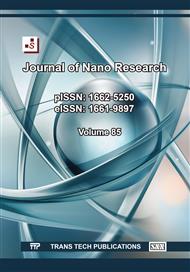[1]
Khan, S "Solid Lipid Nanoparticles A Review", World Journal Of Pharmacy And Pharmaceutical Sciences, 96-115. 2012.
Google Scholar
[2]
Rawat, A., Jain, M. and Singh, A., "Studies on Binary Lipid Matrix Based Solid Lipidnanoparticles of Repaglinide", In Vitro And In Vivo Evaluation, Journal Of Pharmaceutical Sciences. 2. 66-78. 2011.
DOI: 10.1002/jps.22435
Google Scholar
[3]
Sinharanjan, V., Srivastava, S, Honey, G. and Jindal, V, "Solid Lipid Nanoparticles Trends and Implications In Drug Targeting", International Journal of Advances In Pharmaceutical Sciences, 2. 212-238. 2010.
Google Scholar
[4]
Muller, R., Schwarz, C., Mehnertw, and Lucks, J, "Production Of Solid Lipid Nanoparticles For Controlled Drug Delivery", Int. Symp Control Release Bioact. Mater, 1., 480-481. 1993.
Google Scholar
[5]
Yadav, N., Khatak, S. And Singh, S., "Solid Lipid Nanoparticles A Review", International Journal of Applied Pharmaceutics, 5(2). 8-18. 2013.
Google Scholar
[6]
Ekambaram, P., Sathali, A. and Priyanka, K, "Solid Lipid Nanoparticles and Lipid Nanostructures Overview", Scientific Review &Chemical Communication, 2. 216-220. 2011.
Google Scholar
[7]
Manjunath, K.; Reddy, J.S.; Venkateswarlu, V. Solid lipid nanoparticles as drug delivery systems. Methods Find Exp. Clin. Pharmacol. 2005, 27, 127–144. [CrossRef] [PubMed]
DOI: 10.1358/mf.2005.27.2.876286
Google Scholar
[8]
Ekambaram, P.; Sathali, A.; Priyanka, K. Solid lipid nanoparticles: A review. Sci. Rev. Chem. Commun. 2012,2, 80–102.
Google Scholar
[9]
Shazali, S.S.; Amiri, A.; Zubir, M.N.M.; Rozali, S.A.; Zabri, M.Z.; Sabri, M.F.M. Colloidal stability measurements of graphene nanoplatelets covalently functionalized with tetrahydrofurfuryl polyethylene glycol in different organic solvents. Current Applied Physics 2018, 18, 209-219.
DOI: 10.1016/j.cap.2017.10.007
Google Scholar
[10]
Flory PJ. Principles of polymer chemistry. Ithaca (NY): Cornell university press;1953.
Google Scholar
[11]
Sun SF. Physical chemistry of macromolecules: basic principles and issues. 2nd ed. New York: Wiley; 2004.
Google Scholar
[12]
Grosberg AY, Khokhlov AR. Giant Molecules: here, there, and everywhere. 2nd ed. Hackensack, NJ: World Scientific Publishing Company; 2010.
DOI: 10.1007/s10698-011-9134-9
Google Scholar
[13]
Kammer HW. Introduction. In: ChanCH, ChiaCH, ThomaS, editors. Physical chemistry of macromolecules: macro to nanoscales. Waretown, NJ: AAP; 2014.pp.3-8.
Google Scholar
[14]
Yamakawa H. Modern theory of polymer solutions. New York: Harper and Row; 1971.
Google Scholar
[15]
Fujita H. Polymer solutions. Amsterdam: Elsevier science publishers B.V; 1997.
Google Scholar
[16]
Hina S, Zhang Y, Wang H. Characterization of polymeric solutions: a brief overview. Rev Adv Mater Sci. 2014; 36:165-176.
Google Scholar
[17]
Förster S, Schmidt M. Polyelectrolytes in solution. Advances in Polymer Science.1995; 120:51–133.
Google Scholar
[18]
Barat JL, Joanny JF. Theory of polyelectrolyte solutions. In:Prigogine I, Rice.SA, editors. Advances in Chemicl Physics. Vol. 94(Polymeric Systems). New York: John Wiley; 1996. P. 1-66.
Google Scholar
[19]
Sujitha, S.; Dinesh, P.; Rasool, M. Berberine encapsulated PEG-coated liposomes attenuate Wnt1/β-catenin signaling in rheumatoid arthritis via miR-23a activation. European Journal of Pharmaceutics and Biopharmaceutics 2020, 149, 170-191, https://doi.org/10.1016/j.ejpb. 2020.02.007.
DOI: 10.1016/j.ejpb.2020.02.007
Google Scholar
[20]
Melo, M.N.; Pereira, F.M.; Rocha, M.A.; Ribeiro, J.G. Junges, A.; Monteiro, W.F.; Diz, F.M.; Ligabue, R.A.; Morrone, F.B.; Severino, P.; Fricks, A.T. Chitosan and chitosan/PEG nanoparticles loaded with indole-3-carbinol: Characterization, computational study and potential effect on human bladder cancer cells. Materials Science and Engineering: C 2021, 124, 1-14.
DOI: 10.1016/j.msec.2021.112089
Google Scholar
[21]
C. Sanchez-Cano and M. Carril, Int. J. Mol. Sci., 2020, 21, 2–24.
Google Scholar
[22]
K. Rahme and N. Dagher, Pharmaceutics, 2019, 11, 2–23. 8 G. Chen, Y. Wang, R. Xie and S. Gong, Adv. Drug Delivery Rev., 2018, 130, 58–72.
Google Scholar
[23]
Mukherjee S, Ray S, Thakur RS. Solid lipid nanoparticles: a modern formulation approach in drug delivery system. Indian J Pharm Sci. 2009. 71(4):349-58.
DOI: 10.4103/0250-474x.57282
Google Scholar
[24]
Sinha VR, Srivastava S, Goel H, Vinay J. Solid lipid nanoparticles (SLN's) – Trends and implications in drug targeting. International Journal of Advances in Pharmaceutical Sciences. 2010. 1:212-38.
Google Scholar
[25]
Muller-Goymann CC. Physicochemical characterization of colloidal drug delivery systems such as reverse micelles, vesicles, liquid crystals and nanoparticles for topical administration. Eur J Pharm Biopharm. 2004; 58: 343-56.
DOI: 10.1016/j.ejpb.2004.03.028
Google Scholar
[26]
Pinto Reis, C., Neufeld, R. J., Ribeiro, A. J., and Veiga, F. (2006). Nanoencapsulation I. Methods for preparation of drug-loaded polymeric nanoparticles. Nanomedicine 2, 8–21.
DOI: 10.1016/j.nano.2005.12.003
Google Scholar
[27]
Wang, Y., Zhu, L., Dong, Z., Xie, S., Chen, X., Lu, M., et al. (2012b). Preparation and stability study of norfloxacin-loaded solid lipid nanoparticle suspensions. Colloids Surf. B Biointerfaces 98, 105–111.
DOI: 10.1016/j.colsurfb.2012.05.006
Google Scholar
[28]
Westesen, K.; Bunjes, H.; Koch, M.H.J. Physicochemical characterization of lipid nanoparticles and evaluation of their drug loading capacity and sustained release potential. J. Control. Release 1997, 48, 223–236.
DOI: 10.1016/s0168-3659(97)00046-1
Google Scholar
[29]
Viswanath DS, Ghosh TK, Prasad DL, Dutt N K, Rani K P. Viscosity of lquids: theory, estimation, experiment, and data. 2007 Springer. Berlin: Springer; 2007.
Google Scholar
[30]
Huggins, M.L. The Viscosity of Dilute Solutions of Long-Chain Molecules. IV. Dependence on Concentration. J. Am. Chem. Soc.,1942, 64, 2716–2718.
DOI: 10.1021/ja01263a056
Google Scholar
[31]
Houwink R. (1940) Zusammenhang Zwischen Viscosimetrisch und Osmotisch Bestimmten Polymerisationsgradenbei Hoch polymer. J. Prakt. Chem. 1940; 157(1-3):15 – 18.
DOI: 10.1002/prac.19401570102
Google Scholar
[32]
Flory PJ, Fox TG Jr. Treatment of intrinsic viscosities. J AmChem Soc. 1951; 73(5):1904-1908.
Google Scholar
[33]
Flory PJ. Statistical mechanics of chain molecules. New York: Wiley; 1969.
Google Scholar
[34]
Derjaguin, B.V. and Landau, L. "Theory of the stability of strongly charged lyophobic sols and the adhesion of strongly charged particles in solution of electrolytes", Acta Phys. Chim. USSR, 14, 733 (1941)
DOI: 10.1016/0079-6816(93)90013-l
Google Scholar
[35]
Verwey, E.J.W. and Overbeek, J.Th.G. "Theory of the Stability of Lyophobic Colloids", Elsevier (1948)
Google Scholar
[36]
O'Brien, R.W. & White, L.R., J. Chem. Soc., Faraday Trans. II, 74, p.1607, 1978.
Google Scholar
[37]
Lyklema,J. "Fundamentals of Interface and Colloid Science" Vol.1, Academic Press (1993)
Google Scholar
[38]
R.P. Feynman, R.B. Leighton, and M. Sands, The Feynman lectures on physics. Vols 1–3. Addison–Wesley, Reading (1966).
Google Scholar
[39]
G.A.D. Ritchie and D.S. Sivia, Foundations of physics for chemists. Oxford Chemistry Primers, Oxford University Press (2000).
Google Scholar


